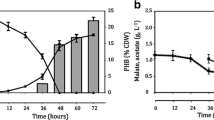Abstract
The mechanism of the aerobic dark assimilation of acetate in the photoheterotrophically grown purple nonsulfur bacteriumRhodospirillum rubrum was studied. Both in the light and in the dark, acetate assimilation inRsp. rubrum cells, which lack the glyoxylate pathway, was accompanied by the excretion of glyoxylate into the growth medium. The assimilation of propionate was accompanied by the excretion of pyruvate. Acetate assimilation was found to be stimulated by bicarbonate, pyruvate, the C4-dicarboxylic acids of the Krebs cycle, and glyoxylate, but not by propionate. These data implied that the citramalate (CM) cycle inRsp. rubrum cells can function as an anaplerotic pathway under aerobic dark conditions. This supposition was confirmed by respiration measurements. The respiration of cells oxidizing acetate depended on the presence of CO2 in the medium. The fact that the intermediates of the CM cycle (citramalate and mesaconate) markedly inhibited acetate assimilation but had almost no effect on cell respiration indicated that citramalate and mesaconate were intermediates of the acetate assimilation pathway. The inhibition of acetate assimilation and cell respiration by itaconate was due to its inhibitory effect on propionyl-CoA carboxylase, an enzyme of the CM cycle. The addition of 5 mM itaconate to extracts ofRsp. rubrum cells inhibited the activity of this enzyme by 85%. The data obtained suggest that the CM cycle continues to function inRsp. rubrum cells that have been grown anaerobically in the light and then transferred to the dark and incubated aerobically.
Similar content being viewed by others
References
Albers, H. and Gottschalk, G., Acetate Metabolism inRhodopseudomonas gelatinosa and Several OtherRhodospirillaceae, Arch. Microbiol., 1976, vol. 111, no. 1/2, pp. 45–49.
Kornberg, H.L. and Lascelles, J., The Formation of Isocitratase by theAthiorhodaceae, J. Gen. Microbiol., 1960, vol. 23, no. 3, pp. 511–517.
Ivanovskii, R.N., Krasil’nikova, E.N., and Berg, I.A., Mechanism of Acetate Assimilation in the Purple Nonsulfur BacteriumRhodospirillum rubrum Lacking Isocitrate Lyase,Mikrobiologiya, 1997, vol. 66, pp. 744–749.
Ivanovsky, R.N., Krasilnikova, E.N., and Berg, I.A., A Proposed Citramalate Cycle for Acetate Assimilation in the Purple Non-Sulfur BacteriumRhodospirillum rubrum, FEMS Microbiol. Lett., 1997, vol. 153, no. 2, pp. 399–404.
Osumi, T., Ebusuno, T., Nakano, H., and Katsuki, H., Formation of β-Methylmalate and Its Conversion to Citramalate inRhodospirillum rubrum, J. Biochem., 1975, vol. 78, no. 4, pp. 763–772.
Osumi, T. and Katsuki, H., A Novel Pathway for L-Citramalate Synthesis inRhodospirillum rubrum, J. Biochem., 1977, vol. 81, no. 3, pp. 771–778.
Beatty, J.T. and Gest, H., Generation of Succinyl-Coenzyme A in Photosynthetic Bacteria,Arch. Microbiol., 1981, vol. 129, no. 5, pp. 335–340.
Beatty, J.T. and Gest, H., Biosynthetic and Bioenergetic Functions of Citric Acid Cycle Reactions inRhodopseudomonas capsulata, J. Bacteriol., 1981, vol. 148, no. 2, pp. 584–593.
Tabita, F.R., The Biochemistry and Metabolic Regulation of Carbon Metabolism and CO2 Fixation in Purple Bacteria,Anoxygenic Photosynthetic Bacteria, Blankenship, R.E., Madigan, M.T., and Bauer, C.R., Eds., Dordrect: Kluwer Academic, 1995, pp. 885–914.
Kornberg, H.L. and Gotto, A.M., The Metabolism of C2 Compounds in Microorganisms: 6. Synthesis of Cell Constituents from Glycollate byPseudomonas sp.,Biochem. J., 1961, vol. 78, no. 1, pp. 69–82.
Olsen, I. and Merrick, J.M., Identification of Propionate as an Endogenous CO2 Acceptor inRhodospirillum rubrum and Properties of Purified Propionyl-CoA Carboxylase,J. Bacteriol., 1968, vol. 95, no. 5, pp. 1174–1178.
Lowry, O.H., Rosebrough, N.J.S., Farr, A.L., and Randall, R.J., Protein Measurement with the Folin Phenol Reagent,J. Biol. Chem., 1951, vol. 193, no. 1, pp. 265–275.
Knight, M., The Photometabolism of Propionate byRhodospirillum rubrum, Biochem. J., 1962, vol. 84, no. 1, pp. 170–185.
Sasaki, T., Motokawa, Y., and Kikuchi, G., Occurrence of Both a-Type and o-Type Cytochromes as the Functional Terminal Oxidases inRhodopseudomonas sphaeroides, Biochim. Biophys. Acta, 1970, vol. 197, no. 2, pp. 284–291.
Ivanovskii, R.N. and Rodova, N.A., Cytochrome Content and Composition inRhodopseudomonas palustris as a Function of Growth Conditions,Mikrobiologiya, 1975, vol. 44, no. 1, pp. 16–20.
Liebergesell, M., Hustede, E., Timm, A., Steinbuchel, A., Fuller, R.C., Lenz, R.W., and Schlegel, H.G., Formation of Poly(3-Hydroxyalkanoates) by Phototrophic and Chemolithotrophic Bacteria,Arch. Microbiol., 1991, vol. 155, no. 5, pp. 415–421.
Yamada, T. and Kikuchi, G., Inhibition of the Metabolism of Carboxylic Acids and Amino Acids by Citramalate and Other Related Compounds inRhodopseudomonas sphaeroides, J. Biochem., 1968, vol. 63, no. 4, pp. 462–471.
Williams, J.O., Roche, T.O., and McFadden, B.A., Mechanism of Action of Isocitrate Lyase fromPseudomonas indigofera, Biochemistry, 1971, vol. 10, no. 8, pp. 1384–1390.
McFadden, B.A. and Purohit, S., Itaconate, an Isocitrate Lyase-directed Inhibitor inPseudomonas indigofera, J. Bacteriol., 1977, vol. 131, no. 1, pp. 136–144.
Author information
Authors and Affiliations
Rights and permissions
About this article
Cite this article
Berg, I.A., Krasil’nikova, E.N. & Ivanovsky, R.N. Investigation of the dark metabolism of acetate in photoheterotrophically grown cells ofRhodospirillum rubrum . Microbiology 69, 7–12 (2000). https://doi.org/10.1007/BF02757248
Received:
Issue Date:
DOI: https://doi.org/10.1007/BF02757248




